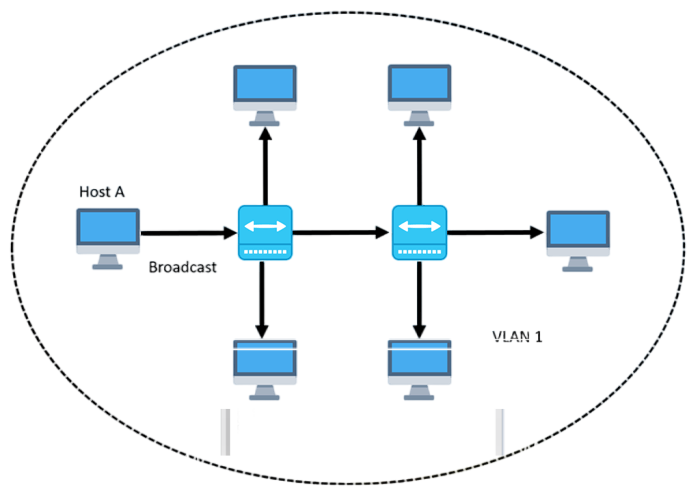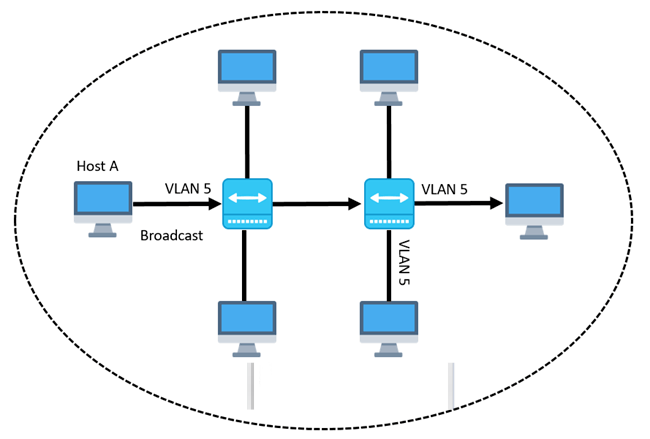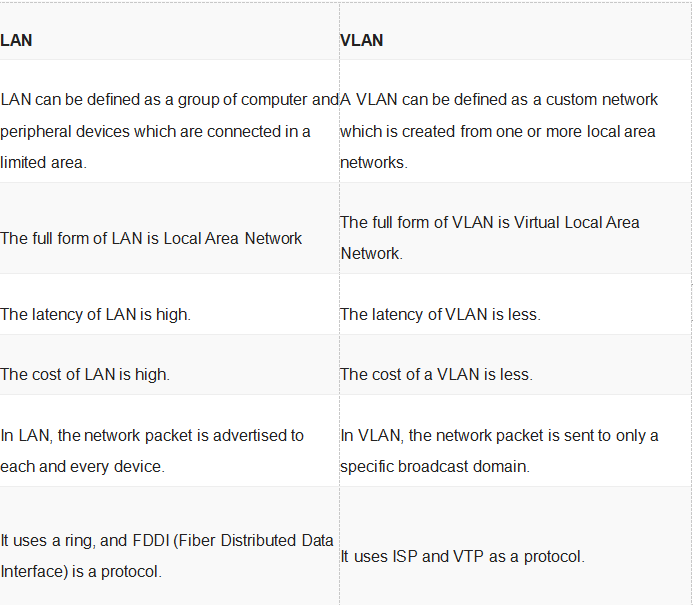
By admin Date of issue: Mar 20,2023
VLAN is a custom network which is created from one or more local area networks. It enables a group of devices available in multiple networks to be combined into one logical network. The result becomes a virtual LAN that is administered like a physical LAN. The full form of VLAN is defined as Virtual Local Area Network.
The below topology depicts a network having all hosts inside the same virtual LAN:

network having all hosts inside the same VLAN
Without VLANs, a broadcast sent from a host can easily reach all network devices. Each and every device will process broadcast received frames. It can increase the CPU overhead on each device and reduce the overall network security.
In case if you place interfaces on both switches into separate VLAN, a broadcast from host A can reach only devices available inside the same VLAN. Hosts of VLANs will not even be aware that the communication took place. This is shown in the below picture:

Host A can reach only devices available inside the same VLAN
VLAN in networking is a virtual extension of LAN. A LAN is a group of computer and peripheral devices which are connected in a limited area such as school, laboratory, home, and office building. It is a widely useful network for sharing resources like files, printers, games, and other applications.
Here are the important characteristics of VLAN:
· Virtual LANs offer structure for making groups of devices, even if their networks are different.
· It increases the broadcast domains possible in a LAN.
· Implementing VLANs reduces the security risks as the number of hosts which are connected to the broadcast domain decreases.
· This is performed by configuring a separate virtual LAN for only the hosts having sensitive information.
· It has a flexible networking model that groups users depending on their departments instead of network location.
· Changing hosts/users on a VLAN is relatively easy. It just needs a new port-level configuration.
· It can reduce congestion by sharing traffic as individual VLAN works as a separate LAN.
· A workstation can be used with full bandwidth at each port.
· Terminal reallocations become easy.
· A VLAN can span multiple switches.
· The link of the trunk can carry traffic for multiple LANs.
Port-based VLANs groups virtual local area network by port. In this type of virtual LAN, a switch port can be configured manually to a member of VLAN.
Devices that are connected to this port will belong to the same broadcast domain that is because all other ports are configured with a similar VLAN number.
The challenge of this type of network is to know which ports are appropriate to each VLAN. The VLAN membership can’t be known just by looking at the physical port of a switch. You can determine it by checking the configuration information.
This type of VLAN processes traffic based on a protocol that can be used to define filtering criteria for tags, which are untagged packets.
In this Virtual Local Area Network, the layer-3 protocol is carried by the frame to determine VLAN membership. It works in multi-protocol environments. This method is not practical in a predominately IP based network.
MAC Based VLAN allows incoming untagged packets to be assigned virtual LAN and, thereby, classify traffic depending on the packet source address. You define a Mac address to VLAN mapping by configuring mapping the entry in MAC to the VLAN table.
This entry is specified using source Mac address proper VLAN ID. The configurations of tables are shared among all device ports.
Here is an important difference between LAN and VLAN:

Here are the important pros/benefits of VLAN:
· It solves a broadcast problem.
· VLAN reduces the size of broadcast domains.
· VLAN allows you to add an additional layer of security.
· It can make device management simple and easier.
· You can make a logical grouping of devices by function rather than location.
· It allows you to create groups of logically connected devices that act like they are on their own network.
· You can logically segment networks based on departments, project teams, or functions.
· VLAN helps you to geographically structure your network to support the growing companies.
· Higher performance and reduced latency.
· VLANs provide increased performance.
· Users may work on sensitive information that must not be viewed by other users.
· VLAN removes the physical boundary.
· It lets you easily segment your network.
· It helps you to enhance network security.
· You can keep hosts separated by VLAN.
· You do not require additional hardware and cabling, which helps you to saves costs.
· It has operational advantages because of changing the IP subnet of the user is in software.
· It reduces the number of devices for particular network topology.
· VLAN makes managing physical devices less complex.
Here are the important cons/ drawbacks of VLAN:
· A packet can leak from one VLAN to other.
· An injected packet may lead to a cyber-attack.
· Threat in a single system may spread a virus through a whole logical network.
· You require an additional router to control the workload in large networks.
· You can face problems in interoperability.
· A VLAN cannot forward network traffic to other VLANs.
Here are the important uses of VLAN:
· VLAN is used when you have 200+ devices on your LAN.
· It is helpful when you have a lot of traffic on a LAN.
· VLAN is ideal when a group of users need more security or being slow down by many broadcasts.
· It is used when users are not on one broadcast domain.
· Make a single switch into multiple switches.
· VLAN is defined as a custom network which is created from one or more local area networks.
· VLAN in networking are identified by a number.
· A Valid range is 1-4094. On a VLAN switch, you assign ports with the proper VLAN number.
· Virtual LANs offer structure for making groups of devices, even if their networks are different.
· The main difference between LAN and VLAN is that In LAN, the network packet is advertised to each and every device Whereas in VLAN, the network packet is sent to only a specific broadcast domain.
· The primary advantage of VLAN is that it reduces the size of broadcast domains.
· The drawback of VLAN is that an injected packet may lead to a cyber-attack.
· VLAN is used when you have 200+ devices on your LAN.
For more products please visit:https://www.wallystech.com/product.html
Follow us in the Youtube:https://www.youtube.com/channel/UClmu7LBz_OWxe2VckkQr3tw
Our product support OpenWRT,please visit our github link for the code : https://github.com/wallystech
We provide superior OEM/ODM/JDM services in wireless communications and customer-specific solution.In addition to the PCBA mainboard, we can also customize indoor or outdoor antennas, which we have extensive experience in. There is also the Tooling. We can do the Tooling for the customer, to undertake a variety of materials mainly metal and plastic enclosure production. Whether antenna enclosure or router enclosure, we can customize for you. Besides of the Qualcomm chips we currently use, we can also use different chips to design according to customers' needs.
ADD:116 ChengYang Road, XiangCheng District, SuZhou City,JiangSu Province, China
Skype:sunbenku1
Email:support@wallystech.com
Copyright © 2020 Wallys Communications (Suzhou ) Co., LTD Sitemap



